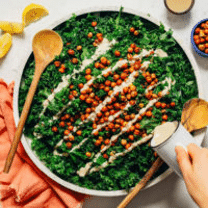
Sulforaphanes are a class of phytochemical. A phytochemical is:
These foods can be taken in raw with salt to help make them more bioavailable as in this meal (noted below), or gently steamed as these foods tend to be high in vitamin C, and the less heat the better. If you do not like the bitterness, consider roasting with a pinch of sea salt to highlight the natural sweet taste of the plant or drizzle with some honey when roasting or after steaming or sautéing.
Ever question how you should take in these foods to get the benefits of the sulforaphanes from those bitter power packed foods? The type in getting the most nutrients is to slice the food to get the active component operating in our bodies.
The dish listed below uses maple syrup in the tahini dressing to mask the bitter element of the kale.
Brassica or cruciferous veggies are the main source of sulforaphanes. There are 375 varieties of brassica veggies that include arugula, bok choy, broccoli, broccoli rabe, brussel sprouts, cabbage, cauliflower, collard greens, dandelion, kale, mizuna, radicchio, radishes, and turnips, merely to name a few. The sulfur component of this phytochemical is what makes these foods bitter, that makes some people turn their nose as much as these power filled foods.
A product from plants that is not a vitamin or mineral No recognized needed quantity in the diet strategy Have health promoting advantages.
Easy Massaged Kale Salad
Dish Source: Minimalist Baker at https://minimalistbaker.com/easy-massaged-kale-salad-15-minutes/
Image Credit: Minimalist Baker
Active Ingredients
Servings: 4
2 huge packages curly kale, big stems eliminated and approximately sliced 1 Tablespoon lemon juice 1 Tablespoon additional virgin olive oil (if preventing oil, leave out) 1 healthy pinch sea salt
DRESSING
1/3 cup tahini 3 Tablespoon lemon juice 1-2 Tablespoon maple syrup (or sub agave, or honey if not vegan) 1 pinch sea salt (optional) Water to thin (~ 3-6 Tablespoon or 45-90 ml as preliminary dish is made up).
Instructions.
GARNISHES optional.
Crispy baked chickpeas.
1. Rinse and dry the kale. Get rid of the green leaves from the stalky stem.
2. Stack your stalks of kale on top of each other and thoroughly slice into bite-size pieces.
Massage the kale with tidy hands for about 3 minutes. The point of massaging is to impart the kale with the lemon juice and oil, and likewise to break down a few of the difficult, fibrous characteristics of kale. Season with salt, massage/toss again, then booked.
4. Next prepare the dressing. Consist of tahini, lemon juice, maple syrup, and salt (optional) to a medium blending bowl. Mix to incorporate. Gradually include water till pourable and velvety. The mix might use up and thicken initially, however continue consisting of water a little at a time, blending till velvety and smooth. Taste and alter taste as required, including more lemon juice for level of acidity, maple syrup for sweet taste, or salt to taste. Reserve. (Shop staying wearing the fridge as much as 5-7 days– typically longer.).
5. Leading with preferred amount of dressing and crispy chickpeas (optional), toss, and serve. Leftovers keep covered in the fridge as much as 3-4 days (not freezer friendly).
There are 375 ranges of brassica veggies that consist of arugula, bok choy, broccoli, broccoli rabe, brussel sprouts, cabbage, cauliflower, collard greens, dandelion, kale, mizuna, radicchio, radishes, and turnips, simply amongst others. The sulfur element of this phytochemical is what makes these foods bitter, that makes some individuals turn their nose as much as these power packed foods.
Serving: 4 portions.
Massage the kale with tidy hands for about 3 minutes. The point of massaging is to impart the kale with the lemon juice and oil, and likewise to break down a few of the hard, fibrous qualities of kale. Taste and change taste as required, including more lemon juice for level of level of acidity, maple syrup for sweet taste, or salt to taste.
Calories: 183 Carbohydrates: 10.8 g, protein: 6.9 g, fat: 14.4 g, hydrogenated fat: 2 g, polyunsaturated Fat: 5.16 g, monounsaturated Fat: 6.5 g, trans Fat: 0 g, Cholesterol: 0 mg, Salt: 46 mg, Potassium: 315 mg, Fiber: 4.4 g, Sugar: 4.4 g, Vitamin A: 4013 IU, Vitamin C: 53.89 mg, Calcium: 81 mg, Iron: 2.22 mg.
Audrey Caspar-Clark MS, RD, LDN, Doris Piccinin, MS, RD, CDE, CSO, LDN, Carly Roop, RD, CSO, MA, LDN, and Caroline Meehan, RDN, CSOWM, LDN, CDCES are the registered dietitians at the Abramson Cancer Center at Perelman Center for Advanced Medication who concentrate on cancer nutrition and deal information based upon sound dietary treatments to support clients throughout their cancer treatment.
Nutrition (1 of 4 portions).








